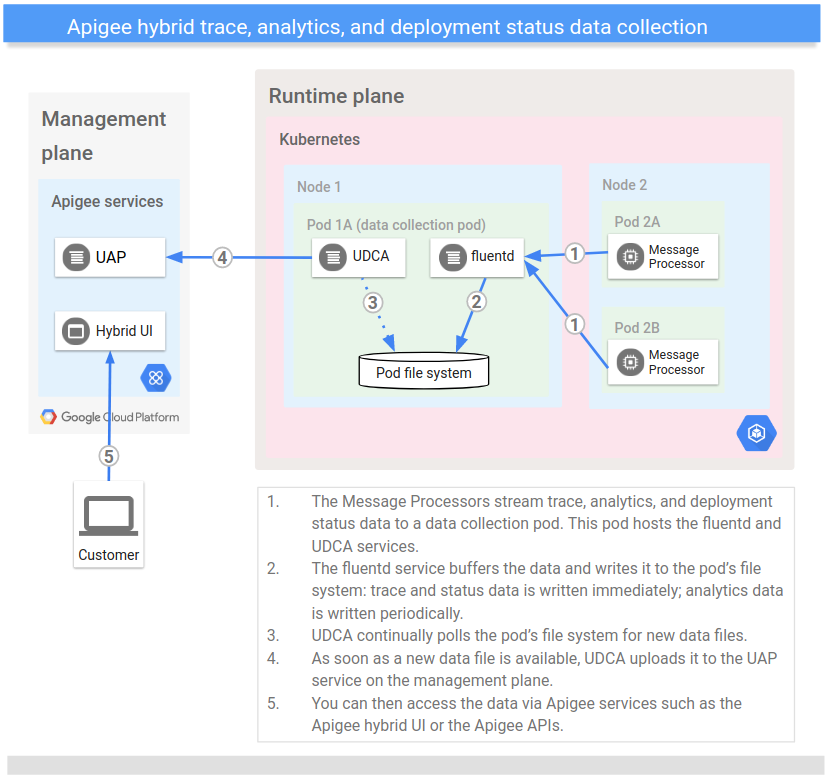A Apigee híbrida disponibiliza para você dados de status de depuração, análise e implantação. Esses dados são coletados por um pod de coleta de dados que os envia ao plano de gerenciamento para que seja possível visualizá-los, analisá-los e configurar o monitoramento e os alertas.
Sobre os dados
Todos os serviços do Processador de mensagens (MP, na sigla em inglês) nos dados de status de depuração de stream híbrido (quando iniciado), análise e implantação por TCP para um pod de coleta de dados no cluster. O pod de coleta de dados armazena os dados transmitidos no sistema de arquivos do pod por meio de um serviço fluentd.
O UDCA (Universal Data Collection Agent) extrai periodicamente os dados armazenados e os envia para o serviço UAP (Unified Analytics Platform) no plano de gerenciamento. O UAP processa os dados recebidos de status de análise e implantação e os disponibiliza na IU híbrida ou nas APIs Apigee.
A Apigee híbrida implementa o pod de coleta de dados como um ReplicaSet com no mínimo duas réplicas.
A imagem a seguir mostra o processo de coleta de dados de status de depuração, análise e implantação:

Os dados de status de depuração, análise e implantação não são armazenados no mesmo local ou acessados da mesma forma que os dados de geração de registros e métricas:
- Os dados de geração e registros e métricas são armazenados no projeto do GCP e acessados por meio de uma ferramenta, como o Stackdriver, ou a que você escolher.
- Os dados de status de depuração, análise e implantação, por outro lado, são armazenados no plano de gerenciamento híbrido, e você os acessa nos serviços da Apigee, como a IU híbrida ou as APIs Apigee.
Na tabela a seguir, resumimos os dados coletados pelo pod de coleta de dados:
| Tipo de dados | Nome do conjunto de dados | Descrição | Frequência de atualização | APIs |
|---|---|---|---|---|
| Análise | api |
Dados de uso da API, incluindo transações por segundo, uso de cache,
erros, latências, tamanhos de solicitações/respostas e contagens de tráfego.
Para mais informações, consulte a Visão geral da Apigee Analytics. |
Atraso de até 30 segundos | API Analytics Admin |
| Status da implantação | event |
O status da implantação atual do proxy de API.
Para mais informações sobre como você vê essas informações, consulte Ver status da implantação. |
Imediatamente | API Deployments |
| Depuração | debug |
Depurar os dados da sessão para proxies de API. Esses dados incluem os parâmetros de solicitação/resposta com transformações aplicadas no momento da execução da política. Devido ao tamanho, os dados de depuração, diferentemente dos dados de status de análise e implantação, não são coletados o tempo todo. Em vez disso, eles são coletados quando você inicia uma sessão de depuração. Para mais informações, consulte Visão geral da depuração. |
Imediatamente | API Debug Session API Debug Session Data |
Visualizar dados na IU híbrida
Nesta seção, descrevemos como visualizar os dados de status de depuração, análise e implantação na IU da Apigee híbrida.
Depuração
Os dados de depuração para serviços híbridos podem ser acessados da mesma maneira que os dados de depuração do Edge, com algumas diferenças, como maior suporte ao filtro. Para mais informações, consulte Visão geral da depuração.
Análise
Os dados de análise para serviços híbridos podem ser acessados da mesma maneira que os dados de análise do Edge. Para mais informações, consulte Como usar os painéis de análise na documentação do Edge.
Status da implantação de proxy
Para informações sobre como ver o status da implantação, consulte Ver o status da implantação.
Configurar a coleta de dados
Para definir como e onde os dados de status de depuração, análise e implantação são coletados no pod de coleta de dados, configure o serviço UDCA nas propriedades de configuração. As propriedades do UDCA incluem tanto as gerais do UDCA quanto as específicas de cada conjunto de dados.
Para configurar o UDCA:
- Abra o arquivo
overrides.yamlpara edição na máquina de administração do Kubernetes, conforme descrito em Gerenciar componentes do plano do ambiente de execução. - Defina os valores das configurações do UDCA. Para o UDCA, é possível definir valores personalizados para
propriedades como:
- Intervalo de pesquisa
- Número de réplicas (mín. e máx.)
- Porcentagem da CPU de destino (que aciona réplicas extras)
Para uma lista completa das propriedades do UDCA que podem ser personalizadas, consulte
udca. - Salve as alterações no arquivo overrides.yaml.
- Aplique as alterações ao cluster executando o comando
apigeectl apply, conforme mostrado no exemplo a seguir:apigeectl apply -f my-overrides.yaml -c udca
Para mais informações sobre o comando
apply, consulte Aplicar plano híbrido ao seu cluster.
